🥬 Cropping System
Farming System, Cropping System, Cropping Pattern and related concepts.
Farming System
Farming system is a complex inter-related matrix of soil, plants, animals, implements, power, labour, capital and other inputs controlled in part by farm families and influenced by varying degrees of political, economic, institutional and social forces that operate at many levels.
For example, it represents combination of farm enterprises such as cropping systems, animal husbandry, fisheries, forestry, sericulture, poultry etc. for optimal utilization of resources bringing prosperity to the farmer.

Principles of Farming System
- Risk minimization
- Use of end products from one enterprise as input in other enterprise
- Recycling of wastes and residues
- Integration of two or more enterprises
- Optimum utilization of all resources
- Maximum productivity and profitability
- Ecological balance
- Generation of employment potential
- Increased input use efficiency
Objectives of Farming System
- Productivity
- Profitability
- Potentiality
- Balanced Food
- Environmental safety
- Income/Cash flow round the year
- Saving energy
- Meeting fodder crises
- Solving timber and fuel crises
- Employment generation
- Scope for establishment of agro-industries: because surplus will be generated.
- Enhancement in input use efficiency
Determinants of Farming System
👉🏻 Factor A represent the physical and biological elements which set limits to the type of agricultural produce to be produced in the given region.
👉🏻 Factor B represent endogenous human elements, which greatly influence the type of farming system adopted in a particular region.
👉🏻 Factor C represents the exogenous human variables, which govern the allocation of available resources by the farmers.
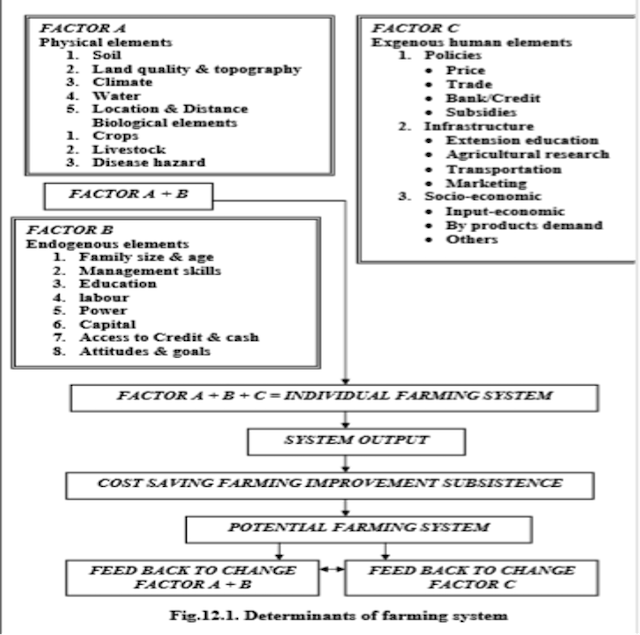
Components of Farming System
- Dairying
- Biogas (Gobar gas) Plant
- Sheep and goat rearing
- Poultry farming
- Fisheries
- Bee-keeping (Apiculture)
- Sericulture
- Agro-forestry
Cropping System
- A cropping system refers to the principles and practices of cropping and their
interactionwith farm resources, technology, aerial and edaphic environment to suit the regional or national or global needs and production strategy. FCI AGM 2021 - It is an important component of farming system.
- The most common cropping system in India is Rice based cropping system.
Cropping Geometry
- The arrangement of the plants in different rows and columns in an area to utilize the natural resources efficiently is called crop geometry.
- It is otherwise area occupied by a single plant.
- Example: Rice: 20 cm X 15 cm.
Cropping Pattern
- Cropping pattern is a
dynamicconcept because it changes overspaceandtime. - The
yearly sequenceandspatial arrangementof crop or of crops and fallow on a given area (a farm), region, province or country apportioning due consideration to natural features (soil and climate), crop efficiency, and capability, socio-economic structure, technological and extension infra-structure (changeable) and the national agricultural policy. - So, we can say that it is combination of crops in time and space.
- Largest cropping system in India is
Rice based cropping system.
(A) Rice Based Cropping Pattern
- This cropping pattern is found in heavy rainfall areas.
- The most traditional areas for rice-based cropping patterns are WB, UP, Bihar, MP, Orissa, AP, Tamil Nadu, Kerala etc.
- The
non-traditional areas arePunjab, Haryana and Western UP. - Total 30 rice-based cropping patterns are adopted in India.
- The most prominent and adopted cropping pattern in India is
Rice - Wheat. - In Bihar, WB & Orissa – summer rice is emerging competing crop to Jute.
(B) Wheat Based Cropping Pattern
- The
non-traditional areas areNorth West India. - Total 19 wheat-based cropping patterns are adopted in India.
- Wheat rotation: Rice – Wheat, Pigeonpea – Wheat, Moong – Wheat etc.
(C) Kharif Sorghum Based Cropping Pattern
- The most prominent areas are Maharashtra, MP, Karnataka, Gujarat, Rajasthan & AP.
- Total 17 kharif sorghum-based cropping patterns are adopted in India.
(D) Rabi Sorghum Based Cropping Pattern
- Total 13 rabi sorghum-based cropping patterns are adopted in India.
(E) Pearl millet Based Cropping Pattern
- This cropping pattern is most prominent in arid and semi-arid tropics i.e. Gujarat & Rajasthan.
- 20 pearl millet-based cropping patterns are adopted in India.
(F) Maize Based Cropping Pattern
- This cropping pattern is most prominent in UP, Bihar, Rajasthan, MP & Punjab.
- 12 maize-based cropping patterns are adopted in India.
(G) Cotton Based Cropping Pattern
- 16 cotton-based cropping patterns are adopted in India mostly in Gujarat, Maharashtra & AP.
(H) Chickpea and Other Pulses Based Cropping Pattern
- The
non-traditional areas areKarnataka, AP & Tamil Nadu.
(I) Groundnut Based Cropping Pattern
- The traditional growing areas are Gujarat, Karnataka, AP & Tamil Nadu.
- Total 9 groundnut-based cropping patterns are adopted in India particularly in rainfed condition.
Multiple Cropping
- Multiple cropping refers to intensification of cropping both in time and space.
- It includes sequential cropping, inter-cropping and mixed cropping.
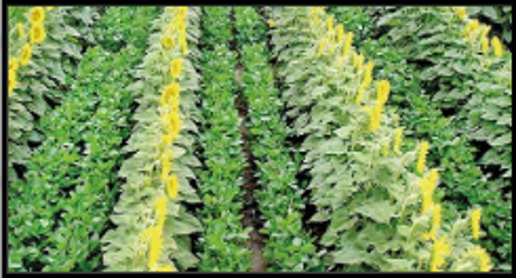
(A) Sequential/Non-overlapped cropping:
- Growing two or more crops in a sequence on the same field in a farming year (twelve months) for irrigated land and is limited to the period of adequate soil moisture availability for crop growth in semi-arid & arid areas.
- The succeeding crop is planted after the preceding crop has been harvested.
- Crop intensification is only in
time dimension. - There is no inter-crop competition.
- Farmers manage only one crop at a time in the same field.
- On the basis of number of crops in a year, it is called double, triple or quadruple cropping.
- Examples of double cropping are Rice-Potato; Rice-mustard; Examples of triple sequential cropping include Rice-Potato-Groundnut.
(B) Intercropping:
- It refers to growing of two or more dissimilar crops simultaneously on the same piece of land, base crop necessarily in distinct row arrangement.
- The recommended optimum plant population of the base crop is suitably combined with appropriate additional plant density of the associated/component crop.
- The objective is intensification of cropping
both in time and space dimensionsand to raise productivity per unit area and inputs by increasing the pressure of plant population.
✅ Advantages of Inter Cropping
- Greater stability of yield over different seasons.
- Better use of growth resources.
- Better control of weeds, pests and diseases.
- One crop provides physical support to the other crop.
- One crop provides shelter to the other crop.
- Erosion control through providing continuous leaf cover over the ground surface, and
- Main the small farmers of limited means benefit with inter-cropping.
❌ Disadvantages of Intercropping
- Yield decrease because of adverse competition effect.
- Allelopathic effect.
- Creates obstruction in the free use of machines for intercultural operations and
- Large farmers with adequate resources may likely to get less benefit out of intercropping.
👉🏻 The following four types of inter-cropping are identified:
- Mixed inter-cropping: Growing component crops simultaneously with no distinct row arrangement. This is commonly used in labour intensive subsistence farming situations.
- Row inter-cropping: Growing component crops simultaneously in different row arrangement. This is used in mechanized agriculture.
- Strip inter-cropping: Growing component crops in different strips wide enough to permit independent cultivation but narrow enough to the crop to interact agronomically.
- Relay inter-cropping: Growing component crops in relay, so that growth cycles overlap. It refers to planting of succeeding crop before the harvest of preceding crop, planting of succeeding crop may be done before or after flowering, before or after attainment of reproductive stage, completion of active life cycle, senescence of leaves or attainment of physiological maturity.
(C) Relay/Overlapped Cropping
- Relay planting is inter-planting or inter sowing of seeds/seedlings of the succeeding crop before harvesting the preceding/maturing crop.
- Generally, 2nd crop is planted after the first crop has reach its reproductive stage of growth e.g., Potato is planted before the harvest of Maize and Radish is sown before harvesting of Potato.
Paira (Bihar & WB)andUtera (MP)cropping are also referred as an example of relay cropping. Paira/Utera cropping means sowing of Lathyrus or Lentil before the harvest of rice in lowland area with an objective to use the residual moisture 💧 of rice field.
Mixed Cropping
- Mixed cropping is growing of two or more crops simultaneously on the same piece of land seeded either after the seeds of the crops intended to be grown mixed or sowing alternate rows in various replacement ratios.
- All crops in mixed cropping should have different life duration and harvested at different time. NABARD 2021
- This may or may not have distinct row arrangement and the mixed plant community faces inter and intra row competition with a different plant type/variety.
- The basic objective in mixed cropping is minimization of risk and insurance against crop failure due to aberrant weather conditions.
- In inter-cropping systems, pressure of plant density per unit area is more than that in a sole cropping system, while in mixed cropping the plant population pressure is generally equal to sole cropping and in some cases, it may even be less than sole cropping system.
- Scientific study of mixed cropping was firstly done by
La-Flitzein 1929. - Mixed cropping is commonly practiced in Dryland areas of India.
- Sowing of seeds is generally by broadcasting method.
- Main objective is to lessen the risk of total crop failure, and to satisfy the farmers in food and fodder.
- Mixed cropping needs irrigation throughout the year.
Sole Cropping/Solid Planting
- It is opposite of intercropping.
- “One crop variety grown alone in pure stands at normal density in a field”.
Monoculture & Monocropping
- If the land is occupied by one crop during one season, the cropping pattern would be Monoculture (
Space Sequence). - If the land is occupied by one crop during one season and next season and next to next season (same crop grown year after year), the cropping pattern would be monocropping (
Time sequence). - It may either be due to climatological limitation or due to specialization by a farmer to grow a particular crop.
Ratooning
- Ratoon cropping is growing a fresh crop from the stubbles or suckers of the plant crop without replanting. It is also referred to as
stubble cropping,re-harvesting,second cropetc. - When we cut crops, some crops have the tendency to resprout this is called ratooning.
- Perfect example of ratoon crop is
sugarcane, in this method when the cane is harvested, a portion of stalk is left underground to give rise to a succeeding growth of cane, the ratoon or stubble crop.
✅ Advantages of the Ratoon Crop:
- Ratoon saves cost on preparatory tillage and planting material.
- It gets benefit of residual manure and moisture.
- It matures earlier.
Mixed Farming
- A system of farming on a particular farm which includes crop production 🌾, raising livestock 🐄, poultry 🐓, fisheries 🐠, bee keeping 🐝 etc. to sustain and safety as many needs of the farmer as possible. The objective is subsistence while higher profitability without altering ecological balance is important in farming system.
- It is based on the principle of give and take. Farm animals feed on farm produce and in return manure is given to the crops.
Crop Rotation
- “The repetitive cultivation of an ordered succession of crops or crops and fellow on the same land.”
- Crop rotation is the reverse of land rotation. In this, crop is rotated year after year.
- The main objective of crop rotation is to maintain and even improves soil fertility and stabilize income.
👉🏻 Example:
- Some insect pests and disease-causing organisms are hosts specific.
- For example, rice stem borer feeds mostly on rice. If you don’t rotate rice with other crops belonging to a different family, the problem continues as food is always available to the pest.
- However, if you plant legume as the next crop, then corn, then beans, then bulbs, the insect pest will likely die due to absence of food (starvation).
✅ Advantages of crop rotation
- Prevents soil depletion
- Maintains soil fertility
- Reduces soil erosion
- Controls insect/mite pests. Crop rotation as a means to control insect pests is most effective when the pests are present before the crop is planted have no wide range of host crops; attack only annual/biennial crops; and do not have the ability to fly from one field to another.
- Reduces reliance on synthetic chemicals
- Reduces the pests’ build-up
- Prevents diseases
- Helps control weeds
Live Mulch System
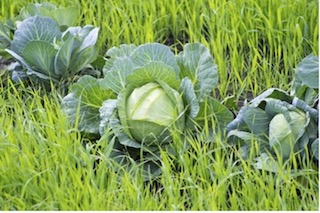
- Live mulch crop production involves planting a food crop directly into a living cover of an established cover crop without tillage or the destruction of the fallow vegetation.
Multistoreyed/ Multitired/Multilevel Cropping

- Two or more than two crops of different heights cultivated simultaneously on the same field.
- It is generally practiced in Karnataka and Kerala.
- E.g. Sugarcane + Mustard + Onion/Potato
Parallel Cropping

- Such crops have different growth habits and zero competition to each other.
- E.g. Urd/Moong + Maize.
Companion Cropping
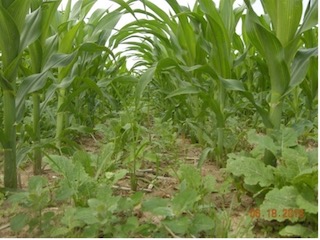
- When the production of both inter crops is equal to that of its solid planting.
- E.g. Mustard/Potato/Onion + Sugarcane.
Synergetic Cropping
- In this type of cropping, yield of both the crops are
higherthan their pure crops on unit area. - E.g., Sugarcane + Potato
Staggered Planting
- It means sowing of a crop is spread over and around optimum period of planting either to minimize risks or to use labour & machinery more effectively or to minimize competition (in inter-cropping) or to prolong the period of supply to the market or the factories.

LER (Land Equivalent Ratio)
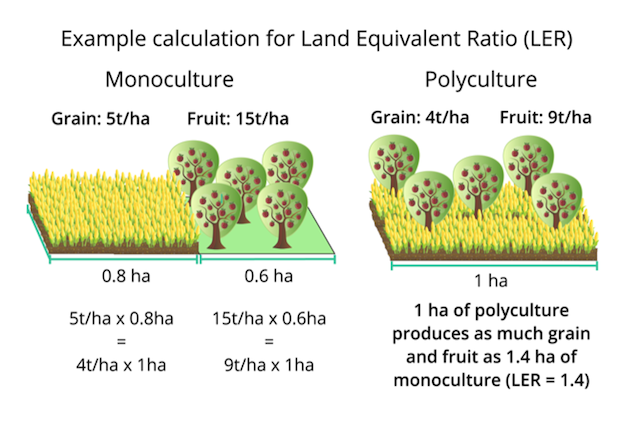
- It denotes relative land area under sole crop required to produce the same yield as obtained under a mixed or an intercropping system at the same level of management.
- lt is the ratio of land required by pure crop to produce the same yield as that of intercrop.
- LER = La + Lb = Ya/Sa + Yb/Sb Where,
- La 👉🏻 LER of crop ‘a’
- Lb 👉🏻 LER of crop ‘b’
- Ya and Yb 👉🏻 Yield of individual crops ‘a’ & ‘b’ respectively in mixture.
- Sa and Sb 👉🏻 Yield of individual crops ‘a’ & ‘b’ respectively in pure stand.
- Let La = 0.70 and Lb = 0.40
- LER = 1.10
- LER = 1.10 means to produce the combined mixture yield by growing in pure stands would require 10% more land i.e. the mixture gives 10% yield advantage.
- Thus, it gives a better picture of the competitive abilities of the component crops. lt also gives actual yield advantage of intercropping.
- In another words LER is the unit to measure the production efficiency of different intercropping system by converting the production in terms of land acreage. LER gives an accurate assessment of the biological efficiency of intercropping.
- When
LER > 1intercropping is beneficial. - Yield advantage obtained in an intercropping system occurs due to the development of temporal and special complementarity.
Cropping Index (CI)
- The number of crops grown per annum on a given area of land multiplied by hundred.
- Example: Cowpea-Rice-Wheat: CI = 300%
Cropping Intensity/Intensity of Cropping
- It refers to raising of a number of crops from the same field during one agricultural year.
Gross Cropped Area
- This represents the total area sown once and/or more than once in a particular year, i.e. the area is counted as many times as there are sowings in a year. This total area is also known as total cropped area or total area sown.
Net Sown Area
- This represents the total area sown with crops and orchards. The area sown more than once in the same year is counted only once.
- Cl = (Total cropping area)/(Net cultivated area) x 100
-
= (Area under Kharif + Rabi + Zaid Crops )/(Area under actual cultivation) - Cropping intensity of India is
143%. - Highest cropping intensity is in
Punjab.
Farming System
Farming system is a complex inter-related matrix of soil, plants, animals, implements, power, labour, capital and other inputs controlled in part by farm families and influenced by varying degrees of political, economic, institutional and social forces that operate at many levels.
For example, it represents combination of farm enterprises such as cropping systems, animal husbandry, fisheries, forestry, sericulture, poultry etc. for optimal utilization of resources bringing prosperity to the farmer.

Principles of Farming System
- Risk minimization
- Use of end products from one enterprise as input in other enterprise
- Recycling of wastes and residues
- Integration of two or more enterprises
- Optimum utilization of all resources
- Maximum productivity and profitability
- Ecological …
Become Successful With AgriDots
Learn the essential skills for getting a seat in the Exam with
🦄 You are a pro member!
Only use this page if purchasing a gift or enterprise account
Plan
- Unlimited access to PRO courses
- Quizzes with hand-picked meme prizes
- Invite to private Discord chat
- Free Sticker emailed
Lifetime
- All PRO-tier benefits
- Single payment, lifetime access
- 4,200 bonus xp points
- Next Level
T-shirt shipped worldwide

Yo! You just found a 20% discount using 👉 EASTEREGG

High-quality fitted cotton shirt produced by Next Level Apparel